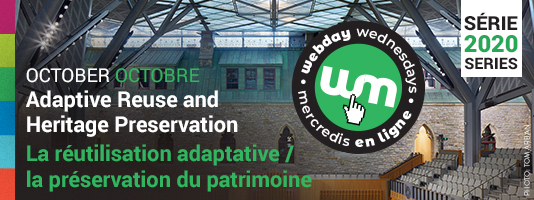Webday Wednesday - Structural Considerations for Old Buildings

Title: Structural Considerations for Old Buildings
Date: October 14, 2020
Old buildings are different than new buildings. This statement seems obvious and yet the most common engineering approaches apply new construction defaults to old building problems. At its best this new construction approach can result in missed opportunities, and at its worst can cause serious damage or even future structural failure of an old building. This presentation will show attendees how to look at the structure of an old building and help them ask critical questions of potential specialist sub-consultants.
Getting the best outcomes for old building structural interventions requires a more integrated process than used for new construction. Technical resources are often difficult to find and challenging to apply in new contexts, and collaboration between conservation specialists, project managers, contractors and trades people is crucial. Conservation-based charters and standards work alongside codes to provide best practices for old buildings. Public opinion often suggests that a conservation project will cost more and is only achievable for major public projects. But when international conservation policy is properly applied to the structure of the building, solutions will better preserve heritage value, decrease project costs, and be practical.
Best solutions for old buildings result from applying a combination of a medical-model approach to the engineering process with the aim to be minimally invasive, compatible, and reversible. This minimizes construction and ensures solutions are unlikely to cause future problems. The medical-model approach for old buildings includes looking at case history; investigation to determine a diagnosis; considerations when selecting appropriate treatments; and finally, continued monitoring. Understanding a building’s structure must also consider the building’s history: how was the building built and what changes have been made over time? This case history can then explain what is currently seen, even if an issue is likely a perceived problem or actual. Visual inspection combined with diagnostic testing can create an understanding of root problems in a building, not just symptoms. Once the underlying problem of the structure is clearly defined, it is possible to look at potential long-lasting treatment options. Problems with a building typically have more than one potential solution and finding the best match for an old building is important. And sometimes an assumed problem turns out not to be a problem at all.
The content of this presentation will be delivered with graphic aids and multiple mini-examples of real projects dealing with specific problems. The focus will be on providing the ability to discuss issues with the design team, and to guide questions that help avoid old building pitfalls.
BIO:
Dr. Tom Morrison, P.Eng., Ph.D., CAHP, APT-RP, ISCARSAH, ICOMOS
Tom Morrison, P.Eng., Ph.D., CAHP, APT-RP, ISCARSAH is principal engineer of Heritage Standing. He holds a masters degree from the Structural Analysis of Historic Construction program in Europe, and a Ph.D. from McGill University looking at seismic evaluation and rehabilitation of existing structures. Past work experience includes a position at the Heritage Conservation Directorate in Public Works, Ottawa.
Tom is an active member of international conservation groups such as the American Preservation Technology society, the Canadian Association of Heritage Professionals and the International Council on Monuments and Sites (a partner of UNESCO). He is a reviewer for World Monuments Watch and is active in National Research Council Canada discussion regarding Code content that would specifically address existing structures. In his current position with Heritage Standing Inc. he is working with a range of structural typologies, focusing exclusively on existing buildings, and enjoying the different engineering problems that come up.
Continuing education learning hours: 1 credit
REGISTRATION DEADLINE: Monday, October 12 at 8:00 p.m. ET
WEBINAR REGISTRATION FEE:
$50 for RAIC members, plus applicable taxes.
$75 for non-members, plus applicable taxes.
SCHEDULE: The Webinar will take place on Wednesday, October 14 at 1 p.m. ET in English.
The Canada-wide schedule by time zone is:
|
|
PACIFIC |
MOUNTAIN |
CENTRAL |
EAST |
ATLANTIC |
NEWFOUNDLAND |
|
START |
10 a.m. |
11 a.m. |
12 noon |
1 p.m. |
2 p.m. |
2:30 p.m. |
|
END |
11 a.m. |
12 noon |
1 p.m. |
2 p.m. |
3 p.m. |
3:30 p.m. |
More information, including online access instructions and a PDF copy of the slides will be sent to you by email on the Tuesday prior to the Webday webinar.
*Purchase of webinars and events are non-transferable.
Webinar/Course Fields
|



